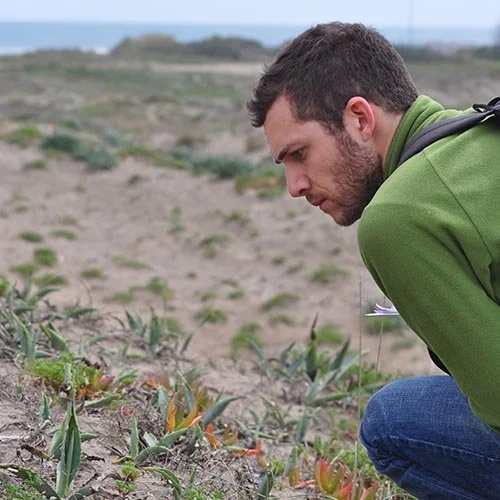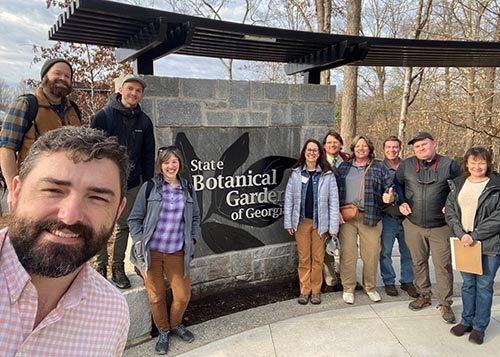April has been an extremely busy and exciting month for us. Education and outreach, volunteer activities, restoration work, networking, and much more are some of the many activities that SGI has been involved with this month. Read this newsletter to hear about all our exciting news and announcements, find out about our upcoming events in May, be reminded of our recent blog articles, and find out the hot topics being discussed in our Facebook group.
News and Announcements
Gabby LeFevre was one of the many SGI team members who presented at the Association of Southeastern Biologists Conference in Little Rock, AR.
SGI partnered with the Austin Peay State University Foundation to accept 62.86 acres of wetland mitigation bank property in the headwaters of the Harpeth River near Eagleville, TN. This property is now placed in a perpetual conservation easement and adds to approximately 60 nearby acres that are already under a conservation easement.
SGI partnered with the Ecological Society of America (ESA) to host a symposium on Southeastern grasslands at the annual Association of Southeastern Biologists Conference held in Little Rock, Arkansas. Dwayne Estes, SGI Executive Director, gave an introduction to the current state of science of Southeastern grasslands. Theo Witsell, SGI Chief Ecologist, spoke about Arkansas’s grasslands. Alan Weakley, SGI Chief Botanist, spoke about our work to develop a Southeastern “grassland fidelity index” with the National Park Service. Dwayne and Chip Morgan, GIS Specialist, delivered a presentation about a volunteer-led project to map Revolutionary War-era “witness trees” in central Tennessee.
Evan Rehm, Austin Peay State University Assistant Professor / SGI Research Associate, and Gabby LeFevre, Graduate Research Assistant, also presented “lightning talks” at the Association of Southeastern Biologists Conference. These high-impact, rapid-fire, 5-minute talks focused on their research studying the impact of climate change on invasive species in restored prairies. Their work is being done at the Google Prairie and is funded by the Southeast Climate Adaptation Science Center.
We were able to help our partners within the Georgia Plant Conservation Alliance rescue a population of the critically imperiled persistent trillium in north Georgia. Photo credit: Patrick Ceska
An article published by Dr. Marcello De Vitis, Director of SGI's Seed Program, and his colleagues was named a Top Cited Article by Wiley Online Library.
Partners within the Georgia Plant Conservation Alliance rescued a population of the critically imperiled persistent trillium (Trillium persistens) in north Georgia. Zach Wood, Georgia Grasslands Coordinator, assisted with the removal of plants which will be temporarily safeguarded by our partners at the State Botanical Garden of Georgia at UGA.
Ted Brancheau joined us as our new Quail Forever/SGI Kentucky Grasslands Regional Conservation Partnership Program (RCPP) Wildlife Biologist. RCPP is a federal Farm Bill program administered by the Natural Resources Conservation Service. Ted is stationed in Richmond, KY and will be working closely with the NRCS and the Kentucky Department of Fish and Wildlife Resources to conserve grasslands on private lands in Kentucky. His position is also in partnership with the American Bird Conservancy, the lead recipient of the Grasslands RCPP grant.
Gabby LeFevre, Graduate Research Assistant, and Laura Hunt, Volunteer Coordinator, shared two presentations with Clarksville High School’s AP Environmental Science classes about the importance of grasslands for carbon sequestration and groundwater infiltration.
Tennessee Naturalist Program participants had the opportunity to go out in the field with Cooper Breeden as he taught a class on forbs, ferns, fungi, and mosses.
Cooper Breeden, Plant Conservation Manager, taught the course Forbs, Ferns, Fungi, and Mosses to two chapters of the Tennessee Naturalist Program. The class provides a whirlwind introduction to the biology, ecology, and identification of various plant (and fungi) groups. Following the lecture, the class takes to the field to apply some of the lessons learned.
Jodi Morgan, Youth Outreach Coordinator, gave 5 pollinator presentations at Woodstock High School to approximately 220 students. As a result, she has been invited to join the Woodstock High School advisory board to offer suggestions on environmental topics students should be learning.
Jeremy French, Interior Plateau Coordinator, was presented with a New Alumni Accomplishment with Character Award by his alma mater, William Penn University, for his contributions to the field of ecology.
Cumberland Plateau Forester, David Lowman, began working with a private landowner in White County, Tennessee to establish an approximately 20 acres oak savanna on a dry ridgetop. The landowner’s goal is to maintain this site in an open savanna to benefit turkeys and other wildlife species.
Students at Austin Peay University learned about iNaturalist and were able to practice using it in the APSU Native Plant Teaching and Research Garden.
Volunteer Coordinator, Laura Hunt, gave an overview of iNaturalist including how it is used in research, conservation, and site management to Austin Peay State University’s Sustainability Club and students in the Sustaining Biodiversity class.
Dwayne Estes, SGI Executive Director, met with The Nature Conservancy’s TN Director, Terry Cook, and US Fish and Wildlife Service Partners for Fish and Wildlife staff (Dustin Boles, Dan Elbert, Robbie Cogburn) to discuss restoration of 70-acres of meadows and savannas at Lytle Bend Park (aka Ravenwood Park), in Nashville. This is a collaborative process with TNC, Nashville Metro Parks & Recreation, US Fish and Wildlife Service Partners Program, and SGI.
Jeremy French, Interior Plateau Coordinator, documented a new population of American bumble bees (Bombus pensylvanicus). The American bumble bee is currently under review for listing on the Endangered Species List due to significant declines in its populations over the last several decades.
SGI partnered with the Steven A. Cohen Military Family Clinic and Dunbar Cave State Park in Tennessee for a Community Conservation Overview Workshop. The workshop included an overview of iNaturalist, documenting plant species, and habitat management activities.
Laura Hunt talked about the importance of Southeastern grasslands with visitors to our table at the Outdoor Murfreesboro Conservation Days in Murfreesboro, Tennessee.
We hosted educational tables at the Cherokee County Ag Expo in Holly Springs, GA and at the Murfreesboro Parks and Recreation Department’s Outdoor Murfreesboro Conservation Days in Murfreesboro, Tennessee.
Zach Wood, Georgia Grasslands Coordinator, participated in the second Annual Fire Ecology Discovery Day at the South Carolina Botanical Garden and contributed to the fire interpretative walks through the recently burned prairie. The event was focused on presenting wildland fire to the community as a valuable part of our landscape and showing how vital it is to conserving the native communities.
SGI participated in the annual meeting of the Tennessee Plant Conservation Alliance at Cedars of Lebanon State Park. The meeting included TPCA updates, presentations from partners, discussions about ongoing projects, and a field trip to a nearby limestone cedar glade.
Marcello DeVitis, Seed Program Director, and Will Overbeck, Assistant Director of the Seeds of Success - Southeast, visited four sites in the Western Pennyroyal Karst Plain and Inner Nashville Basin to scout sites where we may be able to collect seeds for future seed banking and ecological restoration.
Some of our partners at the Mississippi Entomological Museum setting up a Malaise trap to sample insects on the Sumter Farm and Stock Company in the Black Belt ecoregion of Alabama.
Dwayne Estes, Executive Director, and Zach Irick, Southern Appalachian Grasslands Ecologist, led a field trip in Cades Cove, Great Smoky Mountains National Park for the annual GSMNP Wildflower Pilgrimage. The duo discussed the grasslands of the Smokies and nearby regions as well as grassland-dependent plants and animals of the region.
David Lowman, Cumberland Plateau Forester, has assisted with 6 prescribed fires on private land for a total of over 100 acres burned this spring to help landowners manage their properties for wildlife and grassland communities.
Our partners and collaborators with the Mississippi Entomological Museum have begun sampling insects in all the major plant communities on the Sumter Farm and Stock Company in the Black Belt ecoregion of Alabama. They have already documented 15 species of ants, 5 species of grasshoppers, and 12 species of butterflies. Other groups being surveyed include bees, beetles, flies, and moths.
Upcoming Events
May 3-6: Center for Plant Conservation National Meeting
Cooper Breeden, Plant Conservation Manager, and Marcello De Vitis, Seed Program Director, will attend the Center for Plant Conservation National Meeting in Denver, Colorado. This year, the theme is celebrating conservation milestones. Cooper will be present on the launch of SGI's Conservation Seed Bank and, more generally, the larger seed program.
May 12-15: SGI Retreat
Over the past couple of years, SGI has experienced tremendous growth and we now have team members scattered over 5 different states. We are taking a few days to get together in-person and have strategic discussions about the current and future direction of SGI.
May 26: Kentucky's Monarch and Pollinator Plan Stakeholder Meeting
Shannon Trimboli, Interim Director of Communications, will be attending Kentucky's Monarch and Pollinator Plan Stakeholder Meeting at John James Audubon State Park in Henderson, Kentucky.
Recent Blog Articles
5 Most Popular New Discussions this Month from the Southeastern Grasslands Ecology, History, and Biodiversity Facebook Group
A member shared a blog article discussing the concept of Alternative Biome States (ABS), especially as it relates to grasslands and the common public perception of ecological succession and climax communities.
A member shared pictures of blackjack oak, shortleaf pine, and longleaf pine savannas from the Piedmont of Western South Carolina.
A member shared a great video of prairie chickens doing mating displays. Although the video was made in Nebraska, prairie chickens used to be a component of grasslands in Arkansas and even parts of Tennessee as well as other states.
A member asked a question about how to encourage the growth of broomsedge and other warm season native grasses.
Jeremy French shared a photo of a map from that late 1700s / early 1800s that depicted prairie at the mouth of the Pearl River in Coastal Mississippi/Louisiana.










